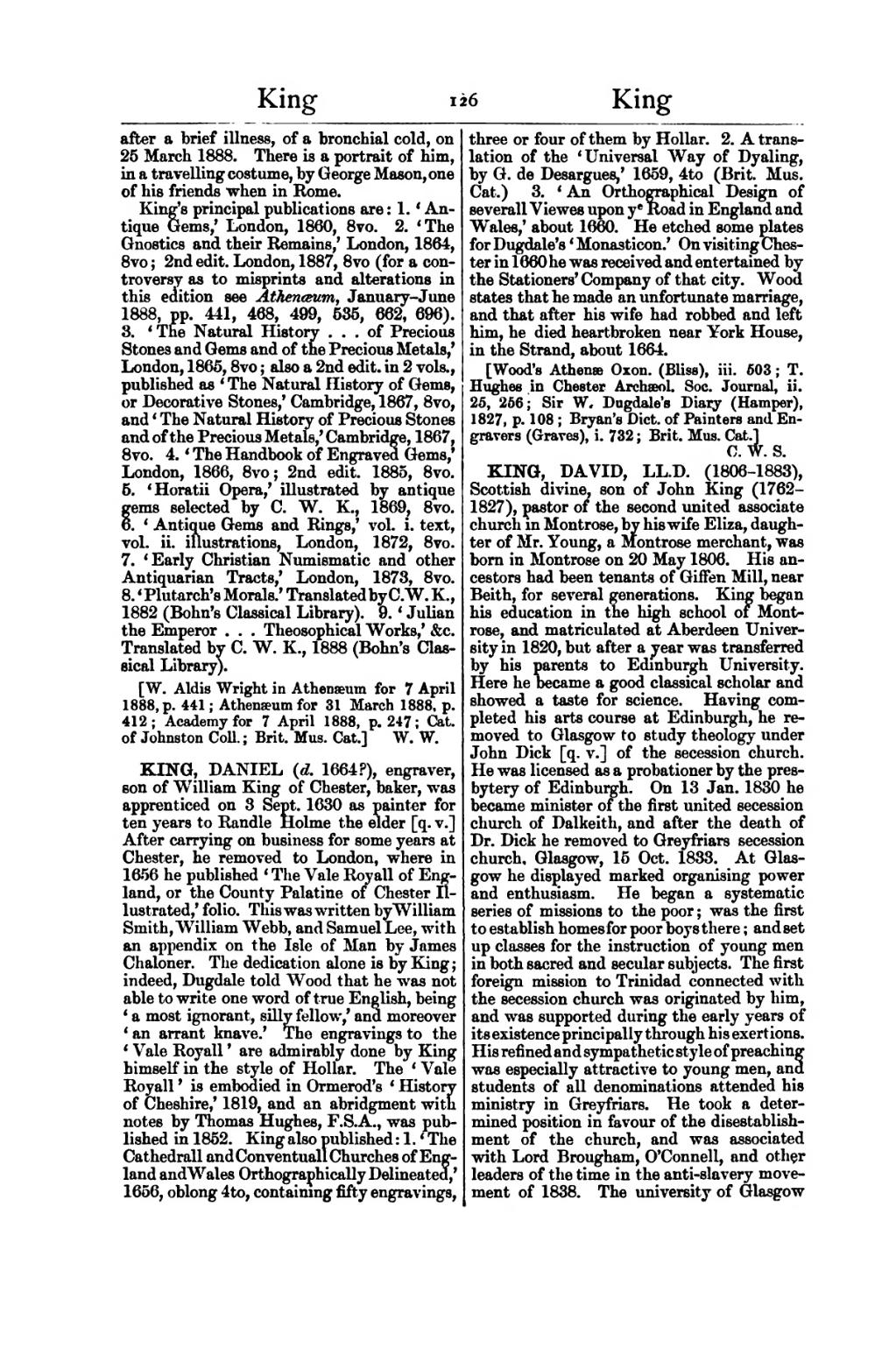after a brief illness, of a bronchial cold, on 25 March 1888. There is a portrait of him, in a travelling costume, by George Mason, one of his friends when in Rome.
King's principal publications are:
- ‘Antique Gems,’ London, 1860, 8vo.
- ‘The Gnostics and their Remains,’ London, 1864, 8vo; 2nd edit. London, 1887, 8vo (for a controversy as to misprints and alterations in this edition see Athenæum, January–June 1888, pp. 441, 468, 499, 535, 662, 696).
- ‘The Natural History … of Precious Stones and Gems and of the Precious Metals,’ London, 1865, 8vo; also a 2nd edit. in 2 vols., published as ‘The Natural History of Gems, or Decorative Stones,’ Cambridge, 1867, 8vo, and ‘The Natural History of Precious Stones and of the Precious Metals,’ Cambridge, 1867, 8vo.
- ‘The Handbook of Engraved Gems,’ London, 1866, 8vo; 2nd edit. 1885, 8vo.
- ‘Horatii Opera,’ illustrated by antique gems selected by C. W. K., 1869, 8vo.
- ‘Antique Gems and Rings,’ vol. i. text, vol. ii. illustrations, London, 1872, 8vo.
- ‘Early Christian Numismatic and other Antiquarian Tracts,’ London, 1873, 8vo.
- ‘Plutarch's Morals.’ Translated by C. W. K., 1882 (Bohn's Classical Library).
- ‘Julian the Emperor … Theosophical Works,’ &c. Translated by C. W. K., 1888 (Bohn's Classical Library).
[W. Aldis Wright in Athenæum for 7 April 1888, p. 441; Athenæum for 31 March 1888, p. 412; Academy for 7 April 1888, p. 247; Cat. of Johnston Coll.; Brit. Mus. Cat.]
KING, DANIEL (d. 1664?), engraver, son of William King of Chester, baker, was apprenticed on 3 Sept. 1630 as painter for ten years to Randle Holme the elder [q. v.] After carrying on business for some years at Chester, he removed to London, where in 1656 he published ‘The Vale Royall of England, or the County Palatine of Chester Illustrated,’ folio. This was written by William Smith, William Webb, and Samuel Lee, with an appendix on the Isle of Man by James Chaloner. The dedication alone is by King; indeed, Dugdale told Wood that he was not able to write one word of true English, being ‘a most ignorant, silly fellow,’ and moreover ‘an arrant knave.’ The engravings to the ‘Vale Royall’ are admirably done by King himself in the style of Hollar. The ‘Vale Royall’ is embodied in Ormerod's ‘History of Cheshire,’ 1819, and an abridgment with notes by Thomas Hughes, F.S.A., was published in 1852. King also published:
- ‘The Cathedrall and Conventuall Churches of England and Wales Orthographically Delineated,’ 1656, oblong 4to, containing fifty engravings, three or four of them by Hollar.
- A translation of the ‘Universal Way of Dyaling, by G. de Desargues,’ 1659, 4to (Brit. Mus. Cat.).
- ‘An Orthographical Design of severall Viewes upon ye Road in England and Wales,’ about 1660.
He etched some plates for Dugdale's ‘Monasticon.’ On visiting Chester in 1660 he was received and entertained by the Stationers' Company of that city. Wood states that he made an unfortunate marriage, and that after his wife had robbed and left him, he died heartbroken near York House, in the Strand, about 1664.
[Wood's Athenæ Oxon. (Bliss), iii. 503; T. Hughes in Chester Archæol. Soc. Journal, ii. 25, 256; Sir W. Dugdale's Diary (Hamper), 1827, p. 108; Bryan's Dict. of Painters and Engravers (Graves), i. 732; Brit. Mus. Cat.]
KING, DAVID, LL.D. (1806–1883), Scottish divine, son of John King (1762–1827), pastor of the second united associate church in Montrose, by his wife Eliza, daughter of Mr. Young, a Montrose merchant, was born in Montrose on 20 May 1806. His ancestors had been tenants of Giffen Mill, near Beith, for several generations. King began his education in the high school of Montrose, and matriculated at Aberdeen University in 1820, but after a year was transferred by his parents to Edinburgh University. Here he became a good classical scholar and showed a taste for science. Having completed his arts course at Edinburgh, he removed to Glasgow to study theology under John Dick [q. v.] of the secession church. He was licensed as a probationer by the presbytery of Edinburgh. On 13 Jan. 1830 he became minister of the first united secession church of Dalkeith, and after the death of Dr. Dick he removed to Greyfriars secession church, Glasgow, 15 Oct. 1833. At Glasgow he displayed marked organising power and enthusiasm. He began a systematic series of missions to the poor; was the first to establish homes for poor boys there; and set up classes for the instruction of young men in both sacred and secular subjects. The first foreign mission to Trinidad connected with the secession church was originated by him, and was supported during the early years of its existence principally through his exertions. His refined and sympathetic style of preaching was especially attractive to young men, and students of all denominations attended his ministry in Greyfriars. He took a determined position in favour of the disestablishment of the church, and was associated with Lord Brougham, O'Connell, and other leaders of the time in the anti-slavery movement of 1838. The university of Glasgow
